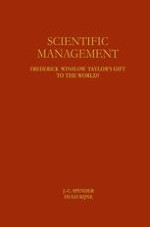1996 | OriginalPaper | Buchkapitel
Scientific Management in Central Eastern Europe — Czechoslovakia, Hungary, and Poland
verfasst von : John Mihalasky
Erschienen in: Scientific Management
Verlag: Springer US
Enthalten in: Professional Book Archive
Aktivieren Sie unsere intelligente Suche, um passende Fachinhalte oder Patente zu finden.
Wählen Sie Textabschnitte aus um mit Künstlicher Intelligenz passenden Patente zu finden. powered by
Markieren Sie Textabschnitte, um KI-gestützt weitere passende Inhalte zu finden. powered by
The history of Scientific Management (SM) in Central and Eastern (CE) Europe was partly determined by the different levels or lack of industrialization in the different regions. The pre-W.W.I Austro-Hungarian empire included most of modern Hungary, Czechoslovakia and the Southeastern part of Poland, the German empire included the western part of Poland, and the Czarist Russian empire included part of Eastern Poland. In the Austro-Hungarian empire, the reigning Habsburgs chose to industrialize the Czech lands of Bohemia and Moravia, which had the raw material resources to support industrialization, rather than the Austrian and Hungarian regions of their empire. In practice, the Hungarian lands were ruled by the Hungarian nobles and recognized as the Greater Kingdom of Hungary. Some industry developed around Budapest, which had good transportation facilities, but other parts of Hungary did not have the resources to support industry. The Slovak part of Czechoslovakia, also dominated by the Hungarians, was kept agricultural, as well as the portion of Poland (Galicia) ruled by the Hungarians. The western part of Poland, under the domination of the Germans, began to industrialize as Germany moved towards industrialization. This part of Poland had plentiful natural resources. Russia was also just beginning to industrialize and the eastern half of Poland had a chance to follow suit.
